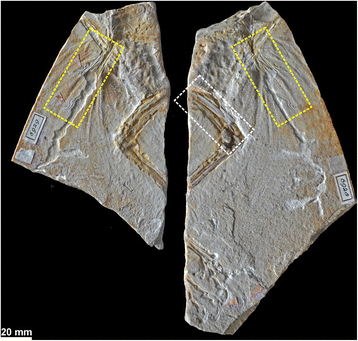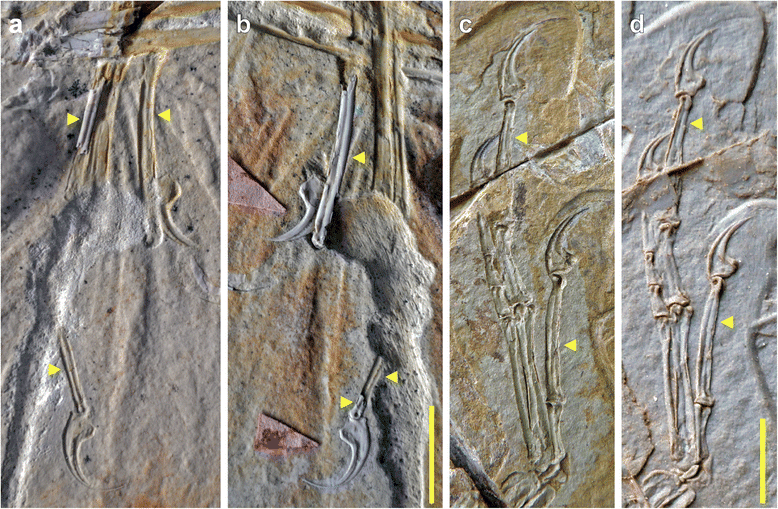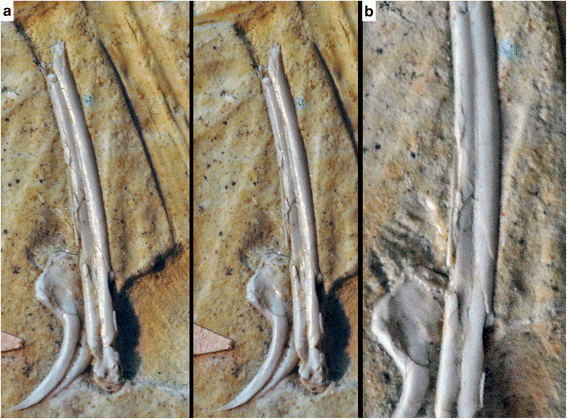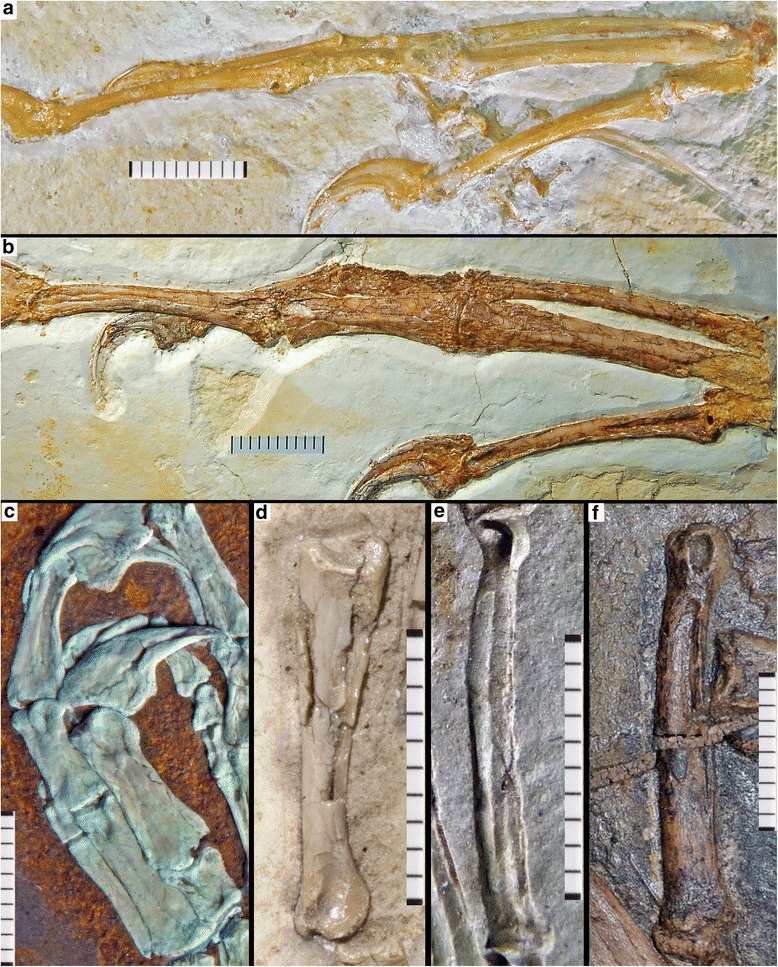@WFS,World Fossil Society,Riffin T Sajeev,Russel T Sajeev
Paleontologists at Ludwig-Maximilians-Universitaet (LMU) in Munich correct a case of misinterpretation: The first fossil “Archaeopteryx” to be discovered is actually a predatory dinosaur belonging to the anchiornithid family, which was previously known only from finds made in China.

Overview of the “Haarlem specimen”, holotype of Ostromia crassipes (Meyer, 1857). Counterslab, Teylers Museum TM 6929 (left) and main slab, TM 6928 (right). Rectangles indicate areas detailed in Fig. 3 (yellow) and Fig. 6 (white)
Even 150 million years after its first appearance on our planet, Archaeopteryx is still good for surprises. The so-called Urvogel has attained an iconic status well beyond the world of paleontology, and it is one of the most famous fossils ever recovered. In all, a dozen fossil specimens have been assigned to the genus. Archaeopteryx remains the oldest known bird fossil, not only documenting the evolutionary transition from reptiles to birds, but also confirming that modern birds are the direct descendants of carnivorous dinosaurs. LMU paleontologist Oliver Rauhut and Christian Foth from the Staatliches Museum für Naturkunde in Stuttgart have re-examined the so-called Haarlem specimen of Archaeopteryx, which is kept in Teylers Museum in that Dutch city and has gone down in history as the first member of this genus to be discovered.

Anatomical details of the manus of Ostromia crassipes and Anchiornis huxleyi. a Detail of the preserved elements of the right manus on the main slab, showing longitudinal furrows (or their impressions) in metacarpal III and the manual phalanges (arrows). b Detail of the preserved elements of the right manus on the counterslab of the holotype of Ostromia crassipes (TM 6929), showing longitudinal furrows (or their impressions) in the manual phalanges (arrows). c, d Impression (c) and high-resolution cast (d) of the left manus of the holotype of Anchiornis huxleyi (Institute of Vertebrate Paleontology and Paleoanthropology IVPP V 14378), showing longitudinal furrows in the manual phalanges (arrows). All scale bars are 10 mm
In the journal BMC Evolutionary Biology, Foth and Rauhut now report that this fossil differs in several important respects from the other known representatives of the genus Archaeopteryx. In fact, their taxonomic analysis displaces it from its alleged perch on the phylogenetic tree: “The Haarlem specimen is not a member of the Archaeopteryx clade,” says Rauhut, a paleontologist in the Department of Earth and Environmental Sciences at LMU who is also affiliated with the Bavarian State Collections for Paleontology and Geology in Munich.

Details of manual phalanx I-1 of Ostromia crassipes, showing the regular development and non-collapsed margins of the longitudinal groove. a, stereophotograph. b, magnification of the shaft of the phalanx
Instead, the two scientists assign the fossil to a group of bird-like maniraptoran dinosaurs known as anchiornithids, which were first identified only a few years ago based on material found in China. These rather small dinosaurs possessed feathers on all four limbs, and they predate the appearance of Archaeopteryx. “The Haarlem fossil is the first member of this group found outside China. And together with Archaeopteryx, it is only the second species of bird-like dinosaur from the Jurassic discovered outside eastern Asia. This makes it even more of a rarity than the true specimens of Archaeopteryx,” Rauhut says.

Manual phalanges of several other theropods preserved in highly compacted sediments, showing differences (a-d, f) and similarities (e) in preservation to the manual furrows in the Haarlem specimen. a Right manus of the Thermopolis specimen of Archaeopteryx, showing non-collapsed phalanges without furrows, as they are found in many specimens of this taxon (e.g. London, Berlin, Eichstätt, Munich, 11th specimen). b Right manus of the Solnhofen specimen of Archaeopteryx, showing partially collapsed and crushed phalanges with clearly broken margins. c Left manus of Sciurumimus albersdoerferi (BMMS BK 11) under UV light, showing partially compressed phalanges in this juvenile theropod. d Phalanx II-2 of Compsognathus longipes (SNSB-BSPG AS I 563), showing non-collapsed, but partially broken shaft. e Impression of phalanx I-1 of the holotype of Anchiornis huxleyi (IVPP V 14378), showing the impression of a regular longitudinal furrow, very similar to the impressions seen in the Haarlem specimen. f Phalanx I-1 of Caudipteryx (IVPP V 12430), showing collapse structure distally with clearly broken margins. Scale bars are in mm increments
Made in China
The Haarlem specimen was found about 10 km to the northeast of the closest Archaeopteryx locality known (Schamhaupten) a full four years before the discovery of the skeleton that would introduce the Urvogel to the scientific world in 1861. Schamhaupten was once part of the so-called Solnhofen archipelago in the Altmühl Valley in southern Bavaria, the area from which all known specimens of the genus Archaeopteryx originated. Its taxonomic reassignment therefore provides new insights into the evolution of the bird-like dinosaurs in the Middle to Late Jurassic. “Our biogeographical analysis demonstrates that the group of dinosaurs that gave rise to birds originated in East Asia — all of the oldest finds have been made in China. As they expanded westward, they also reached the Solnhofen archipelago,” says Christian Foth. Thus, the fossil hitherto incorrectly assigned to the genus Archaeopteryx must have been one of the first members of the group to arrive in Europe.
Around 150 million years ago, the area known today as the Altmühl Valley was dotted with the coral and sponge reefs and lagoons of the Solnhofen archipelago, and the open sea lay to the West and South. The Haarlem fossil was originally recovered from what was then the eastern end of the archipelago, quite close to the mainland. Unlike Archaeopteryx, anchiornithids were unable to fly, and might not have been able to reach areas further offshore. On the other hand, all true fossils of Archaeopteryx found so far were recovered from the lithographic limestone strata further to the west, closer to the open sea. Based on the new findings, Rauhut argues that other known Archaeopteryx fossils may need reassessment: “Not every bird-like fossil that turns up in the fine-grained limestones around Solnhofen need necessarily be a specimen of Archaeopteryx,” he points out.
The authors of the new study have proposed that the Haarlem specimen be assigned to a new genus, for which they suggest the name Ostromia — in honor of the American paleontologist John Ostrom, who first identified the fossil as a theropod dinosaur.
- Christian Foth, Oliver W. M. Rauhut. Re-evaluation of the Haarlem Archaeopteryx and the radiation of maniraptoran theropod dinosaurs. BMC Evolutionary Biology, 2017; 17 (1) DOI: 10.1186/s12862-017-1076-y



 December 5th, 2017
December 5th, 2017  Riffin
Riffin  Posted in
Posted in  Tags:
Tags: 